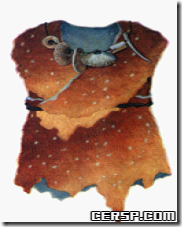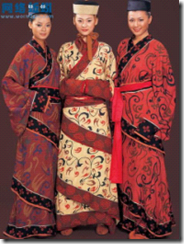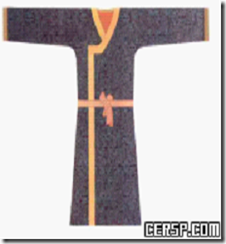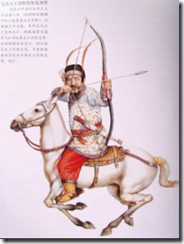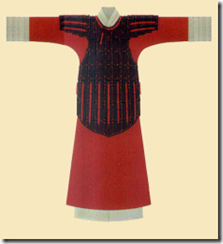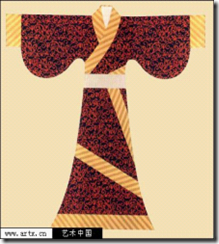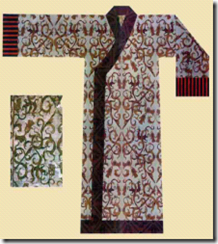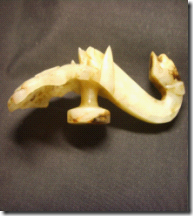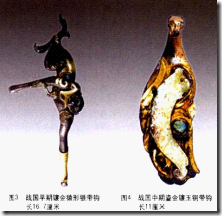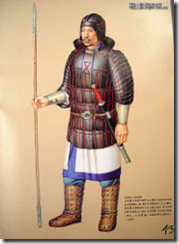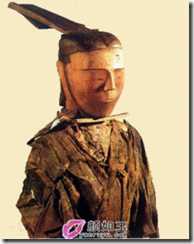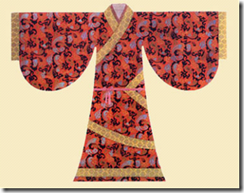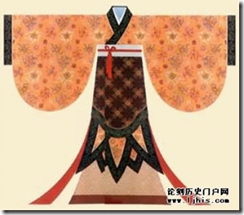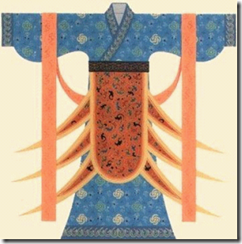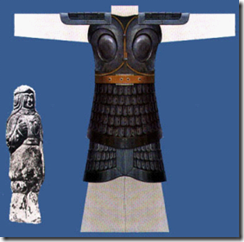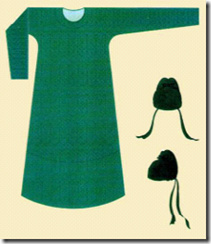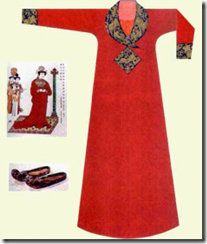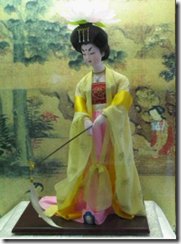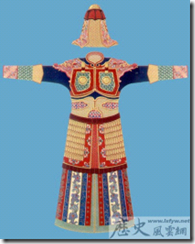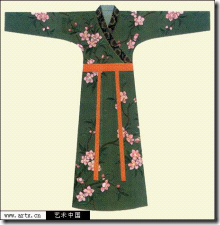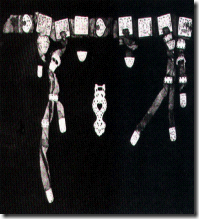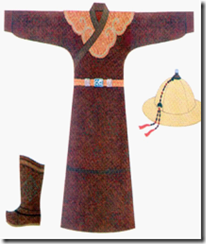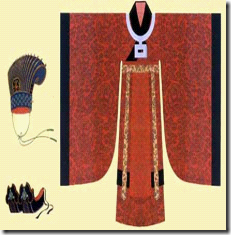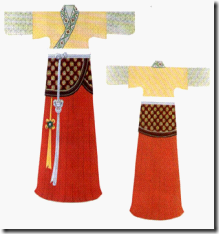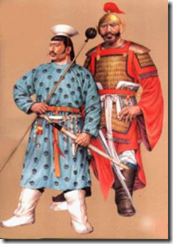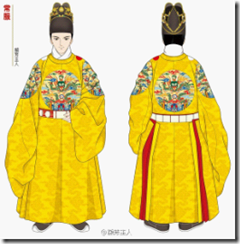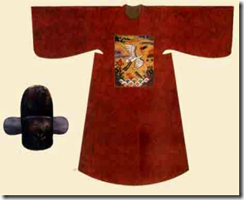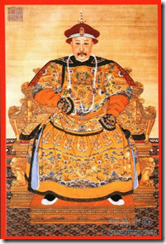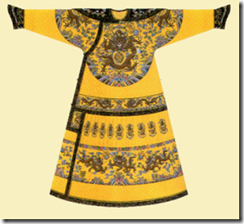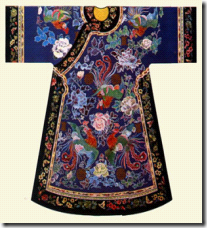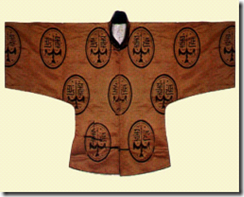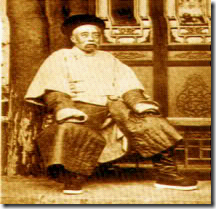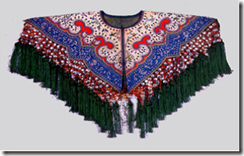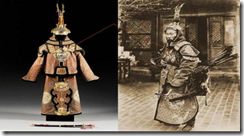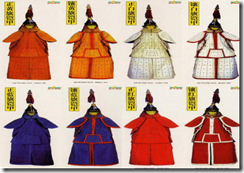Original Clothing
According to the original costumes unearthed bone needles, bone awl and other tools to imagine garment recovery. Before textile technology yet to be invented, it is the main material of animal fur clothing people. Was no rope, wire, animal ligaments may sew clothes. In the cavemen ruins and other ancient tomb, unearthed a large number of layers of decorations, including headdress, necklaces and wrist jewelry and other materials have natural beauty of stone, animal bones and teeth of fish and other sea shells, then wear these ornaments may not only for decoration, and perhaps also contains a memorial to the victory of fishing and hunting.
Shang crest
Shang crest crown worn reel towel, wearing finery aristocratic man (Anyang tomb of Fu Hao Market shares of jade). Wearing clothing cross collar tight sleeves, dressed, covered with a cloud-shaped patterns on the clothing. And gird broadband, belt pressing the lower part of the collar, clothing long knee. Belly hanging a piece of rectangular “cover the knee.” Under shoes. Left lumbar inserted a roll cloud-shaped ornaments, seems to be wearing a kind of sword-class weapon.
Shang and Zhou aristocratic dress
Shang and Zhou aristocratic dress Zhaixiu textured clothing, shelter knee worn impressions FIG. Fabric color during this period to warm as much, especially yellow and red mainly between brown and brown, but it does not mean it does not exist baskets, green and so cool. Cinnabar red, yellow, only two colors to yellow and made of stone, more vivid than other colors, penetration is also strong, so enduring and has been preserved. Analysis by modern science and technology, dyeing method Shang and Zhou dynasties often stained and painted with, especially red, yellow and other Stern, often after the fabric weaves, and then add paint brush. (According to the unearthed jade dress recover drawing)
Dongzhou Man Clothing
Men’s Clothing Dongzhou moment collar tight sleeves long dress show in FIG. Zhou Clothing roughly followed the Shang Dynasty service system, only slightly changed. Style clothes slightly looser than the Shang Dynasty. There are two type sizes sleeves, collar Universal collar moment, the style shown in FIG. Clothing of this period have not twist buckle, generally waist belt, the belt is also linked to some jade ornaments. There are two main belt at the time: a kind of silk fabric, called “big band” or “gentry band.” Another belt made of leather, called “leather belt.” This figure is tied for the gentry band.
Sengoku Hu Fu
Warring States Warring States Period costumes Hu Fu has obvious change, the more important of the popular Hu Fu. The so-called Hu Fu, clothing is actually northwest of ethnic minorities, which are quite different and the Central Plains undress with Bo Han style garments, usually jacket, trousers and leather boots, clothing and body thin narrow, easy activities. Firstly, this garment King Wuling, China is the earliest in the history of clothing a reformer. Knee-length jacket is a major feature of Hu Fu, which was originally used in military clothing, was brought to the public, it has become a common attire.
Warring States women’s clothing
Warring States women’s garment song dark clothing garment song robes shows images (refer unearthed silk painting restoration drawing). Qu garment dark clothing than any other clothing, in addition shirt lower part is connected to this feature, there is a significant difference, called “continued ren crochet.” “Ren” is the skirt. “Ren continued,” is to take a long skirt. “Crochet” is to describe the style skirts. It has changed the method of tailoring the past more than the next clothing styled panties, the left front and rear skirts stitching, longer skirts and rear panel, forming skirts lengthened triangle behind Raozhi wear, then tying the belt.
Sengoku hook
Sengoku hooked hooked using the earliest can be traced back to the Spring and Autumn Period, Shandong, Shaanxi, Henan and other places of the Spring and Autumn Period tombs unearthed in kind frequently found, there are historical records. Since ligation hook up more convenient than with the gentry gradually being widely used, it replaced the silk sash. To the Warring States later, the nobility, celebrities are decorated with hook form a trend. Hooked production are becoming increasingly sophisticated. Its role, in addition to the top of the leather belt to the waist, but also can be installed in the waist side to saber, sword, wear cut, wear mirror, Pei Pei India or other decorative items. After the Northern and Southern Dynasties, a new belt, “walk up and down with the” replaces the envelope with the hook, “Xie Xie” do not hook, but with buckles, hook effect will disappear. This chart from left to right: gold and silver wrong hook, hook jade inlay gold, silver hook jade inlay gold, silver wrong spade hook, hook Qian Bao Chi dragon.
Sengoku warrior costumes
Sengoku samurai clothing Spring and Autumn Period bronze helmet cap (Liaoning unearthed). Helmet During this period, called pocket iron pot, also known as the helmet, the first armored iron pot head or helmet, its shape varied, useful, small pieces decorated a piece compiled into a dome, useful bronze cast into various shapes. In some of the top copper helmet, also tend to have a vertical copper tube to plug antelope and birds tassel ornaments and other decorations when in use. This surface copper helmet, most polished relatively smooth, but inside they are rough rugged, inference, this time wearing a hat samurai helmet, the head should be wrapped turban.
Han Dynasty long crown
Han Dynasty long crown Daichang Guan, wearing robes officials (Changsha Mawangdui unearthed Fashion wooden figurines). Long crown, previously worn the Han emperor Liu Bang, the preparation of bamboo skin, said Liu crown, as well multiply after more official vestments, also known as fasting crown, Changsha Mawangdui unearthed wooden figurines are wearing clothing that is this crown. Qin and Han Dynasties man costume to gowns as expensive. It has been used as dress robes. They base style, and a large multi-sleeves, cuffs obvious convergence, collar, sleeves are decorated with lace. Robes bare neck collar to the main, most heart-cut style, revealing underwear to wear. This is Officials in Han Dynasty robes ordinary attire, regardless of job title can be civil and military wear. This photo shows Dai Changguan with black edge purple robes and crimson tights leaders.
Han Dynasty emperor Mianfu
The Han emperor Qin and Han clothing Mianfu diagram, FIG crown crown, red shoe chart (refer to written records and unearthed pottery Jinan, Yinan tomb unearthed stone relief rehabilitation drawing). The pattern in Fig. According to literature and data recovery drawn patterns on the clothing they use brick painting, painting, painting on silk portrait of brick and the same period and the like. Defending champion, it is the ancient imperial court officials participating in ritual ceremony wearing miter. Used vestments worn by the emperor, princes, etc. Top crown crown, there is a circle in front of the rear crown rectangular plate, plate crown hanging around the “crown tassel.”
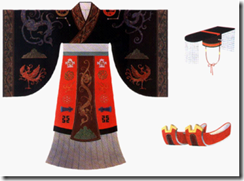 Crown tassel depending on quantity and material, the distinction is an important indicator of your * hierarchy. Provisions of the Han Dynasty, the emperor crown crown of twelve tassel (ie twelve rows), as jade. Crown crown color to black-based. Crown crown on both sides, each with a hole for interspersed jade hairpin, hair tied with the knot. On both sides of the hairpin and tie ribbons in submandibular tying. In the ears of the ribbon on a vertical bead also each named “Yun ear.” Not stuffed ears, but hung in the ear, in order to remind those who wear the crown should not listen to gossip. Future generations “Yun ear does not hear,” a phrase that is resulting. As a rule, those who wear defending champion, must wear Mianfu. Mianfu with mysterious coat, vermilion lower part, painted up and down pattern of Chapter. There are also cover the knee, wear ribbon, red shoes and so on. Consisting of a complete set of clothing. This service system began in the Zhou Dynasty, after the Han, Tang, Song, Yuan Zhu generation has been extended to the Qing Dynasty, stretching over two thousand years.
Crown tassel depending on quantity and material, the distinction is an important indicator of your * hierarchy. Provisions of the Han Dynasty, the emperor crown crown of twelve tassel (ie twelve rows), as jade. Crown crown color to black-based. Crown crown on both sides, each with a hole for interspersed jade hairpin, hair tied with the knot. On both sides of the hairpin and tie ribbons in submandibular tying. In the ears of the ribbon on a vertical bead also each named “Yun ear.” Not stuffed ears, but hung in the ear, in order to remind those who wear the crown should not listen to gossip. Future generations “Yun ear does not hear,” a phrase that is resulting. As a rule, those who wear defending champion, must wear Mianfu. Mianfu with mysterious coat, vermilion lower part, painted up and down pattern of Chapter. There are also cover the knee, wear ribbon, red shoes and so on. Consisting of a complete set of clothing. This service system began in the Zhou Dynasty, after the Han, Tang, Song, Yuan Zhu generation has been extended to the Qing Dynasty, stretching over two thousand years.
Han Dynasty generals armor
Han Dynasty generals Han Dynasty armor armor show FIG. Qin is the most comprehensive data to date in our history, the most accurate and detailed dynasty, which thanks to the discovery of Terracotta Warriors and Horses. From the current in Shaanxi Lintong I, II, III pit excavated pottery, these terracotta sculptures extremely realistic way, not only the characters look lifelike calm demeanor. Qin Dynasty unearthed warriors into the military figurines, Matrimony figurines, knight figurines, figurines shooter, infantry figurines equestrian figurines accumulation, their armor clothing attire exhibit strict hierarchy. This is the armor shape Western drought period, mainly for the generals. A small scaly body with a piece of woven, fourteen five rows. Below the belt and draped shoulder, still with Sapporo armor, in order to facilitate activities.
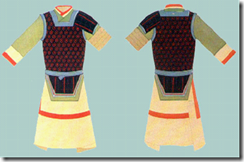 Qin and Han women garment song
Qin and Han women garment song
Qin and Han women garment song dark clothing garment song dark clothing diagram (according to Xi’an, Xuzhou, figurines unearthed clothing restoration drawing) and women’s wear garment curved dark clothing (Xuzhou Tongshan unearthed pottery). Qu Han Dynasty garment dark clothing can be worn not only men, but also women’s wear is the most common form of costumes, the image data has a lot of reflection. The clothing Tongshen Jinzhai, long may drag, it flared hem general, the line does not reveal enough. There are two type width sleeves, cuffs mostly trim. Collar part is quite distinctive, usually cross collar, the collar is very low, so as to expose coat. Such as wearing few clothes, each collar will be exposed to the outside, up to a maximum of three or more, was called “triple clothes.”
Wei and Jin-sleeved shirt big cage crown
Weijin Man-sleeved shirt big cage crown Wei and Jin Dynasties generally wear big sleeves elegant tunic, until the Southern Dynasties, this tunic is still interested in all sectors of the man, became a fad. Cage crown image and Northern tombs unearthed images come first, but time is earlier than other information, is not visible from the cage crown Hu vulgar, but the first in the Central Plains region after popular, and eventually spread to the north, became the Northern Dynasties one of the major crowns. The picture shows the big wide sleeves shirt and paint a diagram showing sarong crown.
Wei, Jin and miscellaneous Juchuishaofu
Wei and Jin Dynasties miscellaneous clothes garment hanging Shao Wei and Jin Dynasties, the traditional dark clothing system has not been adopted men, but among women was still wearing. The clothing compared to the Han Dynasty, has a greater difference. Typical, is decorated with “fiber Shao” in the clothing. The so-called “fiber” refers to a fixed portion of the garment hem ornaments. Usually made of silk fabric, which is characterized by wider at the tip such as triangular, and stacked layers. The so-called “Shao”, referring to the skirts extending from around the streamers. Because for too long streamers, walking, flying as a swallow. To the Northern and Southern Dynasties, the costumes have changed, removed the drag of the streamers, while the cusp of “dovetail” lengthened, so that the two into one. Miscellaneous clothes garment hanging Shao diagram shows
Northern and Southern Mingguang armor
Northern and Southern Dynasties Mingguang armor armor Wei and Jin Dynasties period mainly Yong Kai two sleeves, crotch Mingguang armor and armor. “Mingguang armor,” the source of the term, is said to protect the chest and back and round about. Because most of this round protection to copper and iron and other metal and polished Aurora, resembling a mirror. Wore Mingguang armor on the battlefield due to sun exposure, it will be issued dazzling “Mingguang,” hence the name. Such armor style a lot, and Traditional and Simplified different: some just around the base of each Liang crotch plus two round protection, while others are equipped with shoulder, knee, there are a number of complex heavy Shoulders. A long body mostly to the hip, the waist with a belt line bundle. Figurines left is wearing a pocket iron pot, generals wore Mingguang armor; Below is a diagram showing Mingguang armor worn.
On the Official uniforms gown
Officials in the Tang Dynasty Tang Dynasty costumes Men costumes to Fu Tau gown as yet, also known as Fu head bundle wrapped in cloth head, Han and Wei is in pieces towel on the basis of the formation of a first service. After the Tang Dynasty, people in Fu head which adds a fixed accessories, called “neutron.” Neutron shape each period is different. In addition to external neutron feet Fu head also has many variations, to the Late Tang Dynasty, has been changed from the original soft foot on each side of a hard feet. Tang Dynasty officials, mainly clothing to narrow Xiupao round neck T-shirt, the color had provisions: Where Mishina officials above all with purple; Wupinyishang, Fei is color; six items, seven items are green; eight items, nine [items cyan. After a slight change. Another gown in applying a cross-gown, was also a major feature of the men’s clothing. This soil is a diagram showing the Tang Dynasty Tee gown and leno Fu head FIG.
Middle and Late Tang Uighur women’s wear
Middle and Late Tang Uighur women wear dress show in FIG. Comb Uighur bun, wearing Jinfeng Guan, wearing lady back to late Tang and crane mounted variants Kam Po phase pattern cloud head shoes. Uighur minority in Northwest China, which is now the Uighur predecessor. During the Tang Dynasty Kaiyuan, Uighur was once the most powerful northern minority regime. Uighur peoples and the Han people, has close and friendly relations, mutual cultural exchanges and economic dealings never stopped. Uighur ethnic costumes of Han people who bring a greater impact, especially among women and the women in the palace nobility widely popular. The basic characteristics of Uighur man loaded a little like a robe, lapel, narrow sleeves and bodice large, under long drag. Colors in warm tones, is particularly fond of red. Most of the material texture of thick brocade collar, sleeves are lined with relatively broad woven gold brocade lace. Wearing the garment, usually the hair pulled into a bun-shaped vertebral formula, called “Uighur bun.” On another bun wearing a gold crown studded with gems of peach, Shangzhui phoenix. Temples also generally inserted hairpin hairpin, ears and neck all wear many fine jewelry. Foot wear soft Kam Alice head shoes.
Tang Dynasty Women
With the development of women’s T-shirt kind of the Tang Dynasty is generally divided into jacket, jacket, shirt three. Jacket is a narrow body short Bodysuits clothes or coat. Coat jacket longer than and shorter than gowns, clothing and body more relaxed, but also Bodysuits or cotton. Jacket, long-sleeved jacket with narrow sleeves there are two types. Shirt is sleeveless unlined, the function of sweat, there are buttons down the front and right of junction two kinds. Shirt in spring and autumn days can also be worn on the outside, but short sleeves and wearing a different shirt on the outside, which will develop into back son or half-arms. In the past, it is a kind of skirt shape always rectangular square piece straight skirt, somewhat similar to the kimono dress. Square piece skirt style appear more rigid rigid, so women can not wear them to look pretty. Therefore, the Tang Dynasty, in the form of popular high waist skirt bra, wide swing mopping styles, both revealing curvaceous body structure, but also the performance of a gorgeous chic graceful demeanor. This structure must skirt the main structure of the human body and organic adaptation, it is a circular arc hem pleated skirt oblique, or flared skirt. Incidentally, it is worth mentioning that this will crony beam waist to chest skirt to do also affects North Korean women dress style.
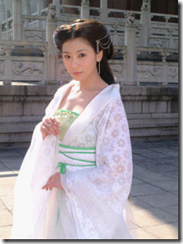
To the late Tang Dynasty, clothing strengthen the traditional Chinese aesthetic concepts to begin retro, gradual recovery from the main body to show the woman to undress big sleeves that Qin and Han dynasties, such as Sin elegant style, clothing style more and more fat, this style set the type has been affecting the basic concept of the late Chinese women, both with loose hypertrophy, which naturally later became a ritual required objects, soft and natural, intangible desire. Women in middle and late gorgeous atmosphere, is generally similar to the dress, which direct them to wear Bra – Bra originally underwear, in the Tang Dynasty and skirts combine to form a whole, it is not a belt, relaxed and natural. Outside direct put blouses, blouses generally read very beautiful, basically dragging swing to ground, some more than a few meters, for example, some 4 feet wide sleeves, garment drag up to 5 feet, and therefore, the same as in the subsequent European hem length determines the status of women. Blouses are generally wide sleeves, wide sleeves that we often see wide sleeves, wide sleeves Tang Dynasty substantially square-shaped sheet, similar to today’s kimono sleeves.
Sui and Tang suit of armor
Sui and Tang Dynasty suit of armor suit of armor for combat, mainly armor and leather. In addition to armor and leather armor, armor Tang Dynasty more commonly used, as well as raw silk armor. A raw silk is a kind of armor with raw silk textiles made it relatively lightweight structure, beautiful appearance, but there is no defense capability, it can not be used for combat only as a military commander with the usual ceremonial dress or attire. The picture shows a diagram showing suit of armor worn.
Northern Liao Dynasty costumes ban
Liao Dynasty Liao Dynasty clothing apparel Ban north to the main robe, men and women alike, and down with the system. Clothing features, usually the left front, round neck, narrow sleeves. New formula pimple on haptics gowns, gowns with tying the chest, then head to the knee. The color is gray robe with gray-green, blue and gray, ocher yellow, black and green and so few, relatively simple patterns. Robe aristocracy, is mostly refined, rust whole body flat pattern. This picture shows the left front narrow Xiupao FIG.
South Liao Dynasty costumes ban
Ban said South Liao Dynasty Liao Dynasty Han Chinese clothing apparel as “Han Chinese clothing,” also known as “South class apparel.” It Khitan “national service” (or “Northern Class apparel”) is different. This dress can be worn not only people, Han officials also can wear. Walk up and down with a belt there, this is Hu made. There are rooms with ring, various objects used Peigua portable applications, such as bows, arrows, count bag, knife, polishing stones and the like. Is also useful in other nations walk up and down the strip. This picture shows the walk up and down with gold (Liaoning Liao tombs unearthed)
Yuan aristocracy Casual
The picture shows the Yuan Dynasty nobility Casual Zhaixiu weaving dragon Jin Pao, corrugated cap, cloud shoulder satin shoe show in FIG. Han Yuan aristocracy attack system, in broad woven clothing dragon. According to the “History of the circle Yu Fu Zhi” records, the emperor worship service with the gun, cover the knee, Hosta, leather belt, ribbon ring decorated with a variety of dragons have only one gun had eight dragons, dragons leaders also hem Excluding. Dragon pattern is created by the Han people, it represents the culture of the Chinese nation. After the Late Tang Dynasty, northern minority regime have been established, all without exception, followed this pattern. To the Yuan Dynasty more prominent, in addition to a large number of costumes with dragon than in other household appliances are also widely used. Yuan Mongolian men do wear one kind of bamboo rattan “corrugated hat”, there are a radius of two styles, the top decorated with jewels.
Yuan woven gold brocade robe
Yuan Yuan aristocratic dress costume with a large number of gold over the past dynasties. Fabric plus gold, as early as the Qin Dynasty had already appeared before. As Han Chinese clothing to get used, some time in the Eastern Han or Eastern Han Dynasty, and mainly used in court. Until the Wei and Jin later, apparel Zhijin atmosphere was popular in the country. Song aristocratic dress with gold in the technology has been developed to eighteen species. Liao, Jin ruled region Zhijin technology has made great progress, especially in the ethnic Uighur region’s most popular, the most beautiful woven cloth. Following the Yuan Liao, Jin, on the fabric with gold more than the previous generation. The picture shows the cross collar woven gold brocade robe to show map.
Yuan Han women’s clothing
Yuan Han women dress physical map is shown in most of the clothing was removed from the tomb in the suburbs of Wuxi one yuan, including inlaid breasted coat and wide-brimmed without edge short jacket, double-breasted, laid out under the panties, lapel collar lined with purple silk caramel side of the vest, single pieces without pleats, skirts and front clip * median cross stitching, of which there are two sides of the pleated skirt discount. There are two styles of shoes, one to a paper made of silk; another element to the production of silk, towering pointed toe vamp decorated a woven silk bow, the Nasi cotton cheesecloth sole system. There chaps, purse and other items are used in the women. Pictured breasted silk jacket; Pictured breasted silk short jacket; folder under the silk skirt (unearthed).
Xixia armor and Rong Fu
Jin and Yuan clothing Xixia is a multi-ethnic kingdom established by the party items Qiang, samurai armor is worn body wrapped, helmet, shoulder draped with exactly the same as if two body armor Song A crotch, knee-length or short as A the main explanation behind the armor, after all, than manufacture some of the Central Plains. Xixia also can be used as the official uniform Rongfu, such as the Khitan Liao Dynasty clothes, like, five significant differences between the two. Because of the extent of the feudal society of the Western Xia is not very deep, the relationship between people is more equal, this hierarchy in clothing is not so strong. The picture shows the Western Xia warrior armor and Rong Fu recovery plan.
The Ming emperor dressed in uniforms
Emperor of the Ming Dynasty emperor dressed in uniforms uniforms show FIG. Uniforms, also known as wing good crown, wearing black yarn discount on towels, dish style of collar, tight sleeves, around the shoulders and embroidered Jin Panlong patterns, jade boots. More use of this service. The Ming emperor dressed in uniforms with yellow silk and clothing, embroidered dragon pattern Zhai and 12 chapters pattern. Dragon motifs from antiquity to the development of the Ming Dynasty, energy, numerous changes. Overall, the pre-Qin dragon, relatively pristine image of rugged, most no limb claw, approximate reptiles. Dragon Qin and Han Dynasty, mostly zoomorphic, limb claw complete, but no scales, often coming up walking like, gives a vague feeling. Ming Dynasty dragon image more perfect, which focused on the local features of various animals, such as cow head, body, such as snake, such as antlers horn, eye, such as shrimp eyes, nose like a lion nose and mouth as the mouth of the donkey, cat ears, such as ear , such as eagle claw, tail, such as fish and so on. In the structure and organization of the pattern it is also very characteristic, in addition to the traditional line Long, Yunlong, as well as dragons, Zhenglong sit Long, Thang Long, Dragon, etc. names. Dragons on this diagram embroidered clothing, there is Thang Long, Dragon two kinds.
Ming Dynasty Empress sleeve clothing
Queen Ming Dynasty Ming Dynasty women’s clothing apparel, mainly sweaters, jacket, Xiapei back son, Bijia and skirts. The basic style of clothing, mostly from the Tang and Song imitation, generally for the right of junction, restore the Han customs. Where Mingfu worn clothing, there are stringent regulations, generally divided into dresses and uniforms. Queen dressed in uniforms of Dailong Feng Chu Chui crown, wearing red clothes big sleeves, plus Xiapei on clothing, Luo red dress, red Bei child, plus dragon decorated on the first Kraft bun, clothes embroidered with Jinlong Feng weave pattern. This photo shows one of the big coat sleeves to show map.
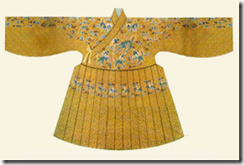
Ming Dynasty officials dressed in uniforms
Ming Dynasty officials dressed in uniforms of the picture shows a view and a missed dose product officer his post. Wearing his post, Fu head, wearing plate collar narrow sleeves gowns. “Pan collar” that is flavored with high collar along the circular opening. This is the Ming Dynasty robes main man costumes, courtiers only available Shishu also may wear, but the color differ. Civilians collar clothing worn disc must avoid black, purple, green, yellow willow, turmeric and bright yellow and other colors, others such as blue, ocher and other unrestricted, commonly known as “pan collar variegated clothes.” Twenty-five years after the founding of the Ming Dynasty, the court officials dressed in uniforms made of new regulations, the civil and military officials, regardless of rank, must be decorated in a Fang Buzi robes chest and back, with birds civilian, military attache with the beasts, to show the difference. This is a Ming Dynasty official uniform of the most distinctive attire.
Man Ming Dynasty robe dajin
Ming Dynasty officials dressed in uniforms five bat holding life pattern dajin robe and wearing a diagram showing the Quartet put down towels, robes worn dajin man. Ming Dynasty men in civilian clothes, the use of gown, its system for the dajin, right Ren, sleeved, knee length down. Aristocratic men casual silk fabrics mainly on painted patterns, also useful for the production of brocade. Patterns gown on, multi-apartment auspicious meaning, and the more common cloud in the middle of the bat, a ball-type embedded “shou” character, meaning “five bat holding life.” This form of pattern especially popular in the seventeenth century, not only in clothing to use on other vessels and architectural decoration are also a lot of reflection. Another, the reality is an abstract decorative flower pattern, usually in lotus, peony flower honeysuckle or as the basic image through distortion, exaggeration, and interspersed with some leaves and buds to form both a dignified and neat, lively and imaginative decorative patterns. This popular clothing patterns at the time. From the Tang Dynasty, Po-phase flowers poured into clothing, a majority of people love the artwork. By the Ming Dynasty, Bao Xiang also became a special flower pattern imperial concubines, and python dragon pattern, like the prohibition against civilian use. But soon lifted prohibitions applied to a variety of clothing. This figure is the former civilian clothes, fabric blue silk, with gold, silver and light blue embroidered dish Longevity pattern.

Men’s Casual Jin Pao Ming Dynasty
Ming Dynasty, the Ming Dynasty officials dressed in uniforms of men in civilian clothes, the use of gown, its system for the dajin, right Ren, sleeved, knee length down. Aristocratic men casual silk fabrics mainly on painted patterns, also useful for the production of brocade. Patterns gown on, multi-apartment auspicious meaning, and the more common cloud in the middle of the bat, a ball-type embedded “shou” character, meaning “five bats holding tho ‘. This type of pattern in the Ming and Qing especially popular, not only in clothing to use on other vessels and architectural decoration also reflects a lot. by a solid phase pattern for casual decor, but also was a feature of man clothing. another, the reality is an abstract flower decorative patterns, usually in lotus, peony flower honeysuckle or as the basic image through distortion, exaggeration, and interspersed with some leaves and buds to form both a dignified and neat, lively and imaginative motifs. this dress patterns at the time by Welcome from the Tang Dynasty, Po-phase flowers poured into clothing, a majority of people love the artwork. the Ming Dynasty, Bao Xiang also became a special flower pattern imperial concubines, and python dragon pattern, like the prohibition against civilian use but soon lifting prohibitions applied to a variety of clothing. this figure is the pattern woven brocade robe Interlocking Po phase diagram shows, the fabric is woven “treasure-phase flowers” patterns of woven gold brocade.
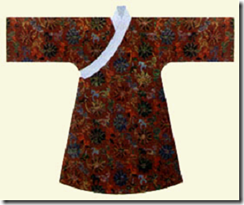
Ming Dynasty jacket skirt
Ming Dynasty jacket skirt dress jacket worn impressions FIG. Under the jacket clothing form skirt, Tang Dynasty women’s major clothing, still certain percentage of women in the Ming Dynasty costumes. On the cross collar jacket, long-sleeved jacket. Color of the skirt, pale early yet, although ornamentation, but not obvious. To Chongzhen Dynasty, mostly in white skirt, even embroidery patterns, it is only in a Qunfu bottom, two inches site decorated with a lace, the presser foot. First Qunfu of six so-called “six footing Xiangjiang River water”; after using eight, there are many fine pleated waist, the line frequently as watermarks. To the late Ming dynasty, skirt decoration increasingly stress, Qunfu has increased to ten, waist pleats and more dense, each pleat has a color, the breeze blowing, the color of moonlight, so called “moonlight skirt” . Often a belt hung with ribbons woven “Palace sash”, the specific image and usage Palace sash as shown generally in the middle of playing a few ring structure, and then head to the ground, some still in the middle of a string on a piece of jade, in order to pressure Qunfu, it does not spread to affect the appearance, function and Song Yuhuan ribbon similar.
Qing Dynasty emperor court dress
Qing Dynasty emperor court dress costumes of the Qing Dynasty emperor has clothes, Kyrgyzstan clothes, uniforms, clothes and other lines. Court dress worn by the emperor and crown, two sub-type summer and winter. The main difference between summer and winter court dress clothes at the edge of the spring and summer with the satin autumn and winter with precious fur of the fringe. Court dress color predominantly yellow to bright yellow as your only ritual day with blue, red, white eve when Asahi. The court dress patterns and 12 chapters mainly dragon patterns. Generally positive front, back and arms are long embroidered each one; waist line curtain embroidered dragon five fold volume (gathers at) before and after the nine dragons embroidered; embroidered skirts Zhenglong two, four lines long; embroidered shawl Long lines two; Zhenglong embroidered sleeve end of each article. XII patterns of sun, moon, stars, mountains, dragons, Hua insects, embroidery, embroidery on clothes in eight chapters; other four algae, fire, were Yi, rice on the clothes, and is equipped with colored moire. The picture shows a diagram showing robes.
Qing dynasty emperor robe
Qing Dynasty emperor court dress costumes of the Qing Dynasty emperor has clothes, Kyrgyzstan clothes, uniforms, clothes and other lines. Kat clothes belong to the emperor’s robes category than court dress, dresses and other clothes Dagon slightly second-class, usually more wear. Wear robes, Kyrgyzstan must wear clothes crown, served with bundles guitar and hanging beads. Ming-yellow robes also available Jinhuang Xing yellow and other colors. In ancient times called emperors, the Ninth of respect. Nine, five two numbers, usually a symbol of elegance, in the royal buildings, appliances and other life are reflected. Qing emperor’s robes, according to historical records, also embroidered with nine dragons. From the physical point of view, before and after only eight dragons, and written records do not match, missing train. Some people think that there is a one-stop emperor itself. In fact, this dragon objective existence, only to be embroidered skirts inside, usually not easy to see. As a result, each piece is actually Kowloon robes, while from the front or back of the watch alone, are seen Wulong, the Ninth of several coincide exactly. In addition, the hem of the robes, diagonally arranged many curved lines that were feet of water. Feet above the water, there are many water waves rolling waves, the waves on the water, but there stands the rocks treasures, commonly known as “sea Jiang Ya”, which in addition to showing endless stretches of auspicious meaning, there are “unified mountains and rivers” and “eternal peace and prosperity,” the implication. The picture shows a diagram showing robes.
Qing Dynasty Empress Phoenix robes
Queen costumes of the Qing Dynasty Empress style uniforms, and similar Manchu ladies apparel, T, dajin, collar, sleeves and skirts the edges are decorated with a wide lace, but the pattern is different. This figure shows the patterns of clothing phoenix wear peony. The whole garment in bright blue satin ground embroidered eight phoenix, phoenix middle, interspersed with a few flowers peony. Peony color processing net Mu and sober color changes Koreto, with traditional landscape features. In contrast, the relatively strong phoenix color, red and green contrast very strong, with a typical national style and characteristics of the times. This picture shows the Queen wore gowns phoenix FIG.
Qing Dynasty pipa lapel jacket
Men’s clothing Qing Dynasty Qing Dynasty clothing mainly robes, coat, jacket, shirt, pants and the like. Paogua is the most important dress. One of these rows gown, waist length however, only cover the elbow sleeve, short-sleeved jacket easy riding, so called “jacket.” The jacket is double-breasted shape, and lack dajin lapel (pipa lapel) of difference. When the multi-breasted jacket dress. Dajin jacket more as uniforms, usually wear robes outside. Lack lapel (Pipa lapel) jacket as more luggage. Mostly short-sleeved jacket, wide sleeves straight. In addition to the color yellow, in general, one more day as a blue or cyan dollar dress. Other dark red, light green, Jiang Zi, dark blue, dark gray and so could be used for uniforms. The picture shows the pipa lapel jacket.
Late Qing Yun shoulder
Qing Dynasty Mingfu cloud shoulder dresses for women draped over shoulder ornament. Has, for the Snap wishful shape when the Five. Ming Dynasty women as decoration on the dress. Women in Qing also used in the wedding dress. Late Qing Jiangnan women comb hair drooping, greasy hair is shoulder afraid clothes soiled, it is more in the shoulder Dai Yun shoulder. Aristocratic women used cloud shoulder, beautifully produced, some tailored to the lotus-shaped, or shaped knot line Ying Luo, hanging around there to be ranked. Cloud shoulder Empress used, some large, round pearls into Ji, a cloud shoulder with 3500 pearls woven. The picture shows the late Qing cloud shoulder kind.
Qing Dynasty Warrior armor
Qing Dynasty Qing Dynasty clothing headwear in general, whether it be iron or leather, are painted on the surface. Around helmet cap around each a beam, forehead middle projecting a shadow eyebrow, on which dance engine and cover the bowl with the shape of sake cup helmet disc bowl, intermediate helmet plate erected a plug Ying gun, eagle feathers or otter tail with iron or brass. After hanging azurite and other colored silk protective collar, neck protection and ear protection, embroidered patterns and decorated with copper or iron Nails. Sub clothing and armor armor around skirts. A clothing shoulders Shoulders equipped with protection under axillary Shoulders; the other in the front and back of a piece of metal wear care center mirror, seams another endoscopic breast care abdomen wear a trapezoid, called “front door” . The left waist wear “left block” right not wear gear, wear bow bag reserved for other purposes. Wai Sang divided into left and right two, when worn with a belt tied around his waist. In the middle of the circumference between the two skirts, covered with the same material tiger cover the knee. The picture shows the Qing wear headwear, wear armor warrior recovery plan.
Eight Banners soldiers armor
Qing Dynasty Qing Dynasty clothing headwear in general, whether it be iron or leather, are painted on the surface. Around helmet cap around each a beam, forehead middle projecting a shadow eyebrow, on which dance engine and cover the bowl with the shape of sake cup helmet disc bowl, intermediate helmet plate erected a plug Ying gun, eagle feathers or otter tail with iron or brass. After hanging azurite and other colored silk protective collar, neck protection and ear protection, embroidered patterns and decorated with copper or iron Nails. Sub clothing and armor armor around skirts. A clothing shoulders Shoulders equipped with protection under axillary Shoulders; the other in the front and back of a piece of metal wear care center mirror, seams another endoscopic breast care abdomen wear a trapezoid, called “front door” . The left waist wear “left block” right not wear gear, wear bow bag reserved for other purposes. Wai Sang divided into left and right two, when worn with a belt tied around his waist. In the middle of the circumference between the two skirts, covered with the same material tiger cover the knee. Eight Banners soldiers armor, made of leather. This time for the big parade wearing clothes, usually covered up. In addition to full Banners of the Qing Dynasty, the Eight Banners of Mongolia in Mongolia located in Han Han Banners set to participate in the real parade of twenty-four flag. The picture shows the Manchu Eight Banners in fashion, from left to right: are yellow, white flag, inlaid red, Zhenglan Banner, Xianghuangqi, white flag, red flag Blue Flag.
Taiping sleeved dress
Taiping Heavenly Kingdom in the Qing Dynasty Qing Dynasty clothing women’s clothing, although some provisions, but not critical. Women generally do not wear horn hats and summer hat, mostly with satin tie amount winter also wear a hood. The initial uprising, most women wear men’s wear, also wearing seedlings installed. After the capital in Tianjing, due to the improvement of living conditions, more women do not wear men’s clothing, depending on the status of the use of simplified design patterns vary. Ordinary women wore robes made of variously colored satin. In the main round neck style collar was very small, relatively fit waist, hem relatively loose, long clothing knee, left ren. In order to facilitate activities, often laid out next panties, or open on both sides, or open in the middle. The picture shows the Qing Dynasty, when Taiping sleeved women’s wear show in FIG.

